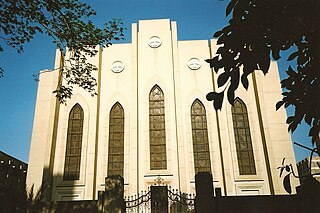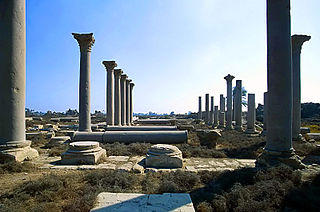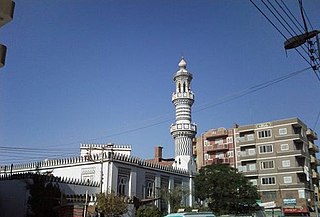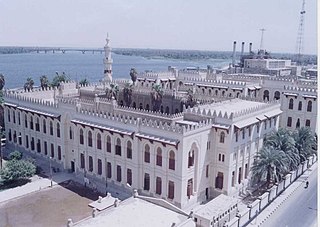
The Coptic Catholic Church is an Eastern Catholic particular church in full communion with the Catholic Church. Along with the Ethiopian Catholic Church and Eritrean Catholic Church, it belongs to the Alexandrian liturgical tradition. Uniquely among the Alexandrian Rite Eastern Catholic liturgies, the Coptic Catholic Church uses the Coptic Rite and the Coptic language in its liturgy; the Ethiopian Catholic Church and Eritrean Catholic Church use the Ge'ez Rite.

The Catholic Church in Egypt is considerably small as compared to the rest of the Christian population in Egypt, which is a significant minority among Muslims. The Catholic population in Egypt is said to have begun during the British control of Egypt. However, many returned to Europe after the 1952 Revolution in Egypt, which also caused the overthrow and exile of King Farouk of Egypt. Catholics in Egypt belong to seven distinct ritual Particular Churches sui iuris, the largest being the Coptic Catholic Church, led by its Patriarch of Alexandria.

Hermopolis was a major city in antiquity, located near the boundary between Lower and Upper Egypt.

The Coptic Catholic Patriarchate of Alexandria is the Patriarchal and only Metropolitan see of the head of the Eastern sui iuris Coptic Catholic Church, a particular Church in the Catholic Church in full communion with the Holy See, which follows the Alexandrian Rite in its own Coptic language. He is thus the superior of all Coptic dioceses, mostly in and around Egypt, the word Copt(ic) being a corruption of the Greek word for Egypt(ian).

Mallawi is a city in Egypt, located in the governorate of Minya.

Asyut is the capital of the modern Asyut Governorate in Egypt. It was built close to the ancient city of the same name, which is situated nearby. The modern city is located at 27°11′00″N31°10′00″E, while the ancient city is located at 27°10′00″N31°08′00″E. The city is home to one of the largest Coptic Catholic churches in the country.
Matai is a city in the Minya Governorate in Upper Egypt. It lies between Samalout and Beni Mazar. It is identified with the ancient town of Matoi and its name comes from the Coptic word for "soldier".
The Holy Synod of the Coptic Orthodox Church of Alexandria is the highest Orthodox authority in the Coptic Orthodox Church. It formulates the rules and regulations regarding matters of the Church's organisation and faith.

Minya Governorate is one of the governorates of Upper Egypt. Its capital city, Minya, is located on the left bank of the Nile River.

Minya is the capital of the Minya Governorate in Upper Egypt. It is located approximately 245 km (152 mi) south of Cairo on the western bank of the Nile River, which flows north through the city.

Egypt is divided, for the purpose of public administration, according to a three-layer hierarchy and some districts are further subdivided, creating an occasional fourth layer.

The Monastery of Saint Fana is a Coptic Orthodox monastery. It is named after Saint Fana, also known as Bane, Coptic Christian hermit. The monastery is sometimes called the Monastery of Abu Fanah and is also known as the Monastery of the Cross, due to the presence of many beautifully decorated crosses inside its church.

The persecution of Copts and the discrimination against Coptic Orthodox Christians are historic and widespread issues in Egypt. They are also prominent examples of the poor status of Christians in the Middle East despite the fact that the religion is native to the Middle East, and its practices are old in the country dating back to the Roman Era. Copts are the Christ followers in Egypt, usually Oriental Orthodox, who currently make up 5 to 10% of the population of Egypt—the largest religious minority of that country. Copts have cited instances of persecution throughout their history and Human Rights Watch has noted "growing religious intolerance" and sectarian violence against Coptic Christians in recent years, as well as a failure by the Egyptian government to effectively investigate properly and prosecute those responsible. Since 2011 hundreds of Egyptian Copts have been killed in sectarian clashes, and many homes, churches and businesses have been destroyed. In just one province (Minya), 77 cases of sectarian attacks on Copts between 2011 and 2016 have been documented by the Egyptian Initiative for Personal Rights. The abduction and disappearance of Coptic Christian women and girls also remains a serious ongoing problem.
The Coptic Catholic Eparchy of Minya is a suffragan eparchy of the Coptic Catholic Church in its sole ecclesiastical province, that of the Coptic Catholic Patriarch of Alexandria.
The Coptic Catholic Eparchy of Giza is an Eastern Catholic diocese in Giza. It is one of the suffragan sees comprising the sole ecclesiastical province of the Coptic Catholic Patriarch of Alexandria, the head of the Coptic Catholic Church, a Particular church sui iuris.
On 26 May 2017, masked gunmen opened fire on a convoy carrying Copts from Maghagha in Egypt's Minya Governorate to the Monastery of Saint Samuel the Confessor, killing at least 28 people and injuring 22 others.
On November 2, 2018, masked gunmen opened fire on a group of Egyptian Christians traveling by bus through Minya. There was a convoy of three vehicles and two of them managed to escape. The vehicles were carrying Copts traveling from Sohag Governorate and Minya Governorate in Egypt to the Monastery of Saint Samuel the Confessor. At least 7 people from Minya were killed while 12 others were injured. A similar attack near the same place had happened in 2017.
Nefrusy was an ancient Egyptian city which location is north of modern day cities of El Ashmunein and El Quseyya. It is known for being the site of Battle of Nefrusy between the forces of Kamose and Hyksos forces, which saw the first attested use of chariots in the history of Military of ancient Egypt.











